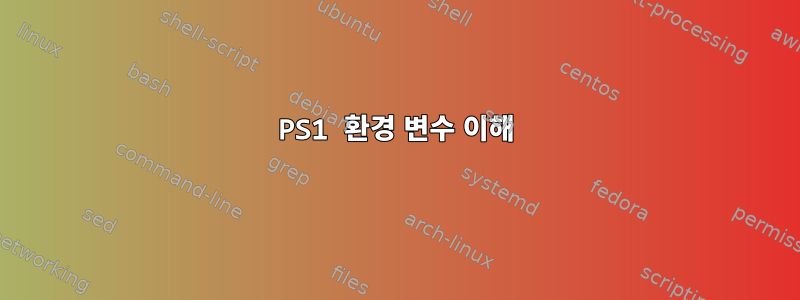
PS1Stackoverflow에서 방금 Linux 터미널 프롬프트를 담당하는 환경 변수에 대한 질문을 봤습니다 .
내 팁은 다음과 같습니다.
username@PORT-usr:/dir
usernameWSL에 로그인할 때 사용하는 사용자 이름입니다.PORT-usr내 노트북 이름이에요./dir내 현재 디렉토리입니다.
내 PS1환경 변수는 다음과 같습니다.
Prompt>echo $PS1
\[\e]0;\u@\h: \w\a\]${debian_chroot:+($debian_chroot)}\[\033[01;32m\]\u@\h\[\033[00m\]:\[\033[01;34m\]\w\[\033[00m\]\$
이렇게 하려고 해도 작동하지 않습니다.
Prompt>echo $($PS1)
\[\e]0;\u@\h:: command not found
Prompt>echo echo $(\[\e]0;\u@\h: \w\a\]${debian_chroot...)
e]0: command not found
u@h:: command not found
32m]u@h[033[00m]:[033[01: command not found
34m]w[033[00m]$: command not found
사용된 변수의 구문은 무엇입니까 $PS1? 이 구문을 이해하는 방법을 배우려면 어떤 명령을 사용할 수 있습니까?
답변1
쉘 PS1변수(환경 변수일 수도 있고 아닐 수도 있음)에는 일반 쉘 명령이 포함되지 않습니다. 사용 중인 다양한 쉘에 특정한 특수 프로세스를 사용하여 프롬프트로 확장됩니다. echo일반 명령으로 인식되지 않는 특수 시퀀스가 포함될 수 있습니다 .
쉘 프롬프트는 Debian(및 관련 배포판)의 기본 프롬프트처럼 보입니다. 일반 사용자 계정에 대한 데비안의 기본 셸은 이므로 bash확인해야 합니다 PROMPTING. man bash또는6.9장:제어 프롬프트배쉬 참조 매뉴얼.
내장된 터미널 제어 코드를 이해하려면 터미널 에뮬레이터에 해당하는 문서를 참조해야 할 수도 있습니다.Xterm 제어 시퀀스 참조.
현재 프롬프트가 해석되는 방법은 다음과 같습니다.
\[ ... \] encapsulates any terminal control codes that will not result in
any visible output on the prompt line
\e]0; Xterm control code to set terminal window title and icon name
\u@\h: \w expands to window title <username>@<hostname>: <workdir>
\a indicates the end of terminal window title / icon name string
\] end of encapsulation
${debian_chroot:+($debian_chroot)}
if variable $debian_chroot is defined, adds text
"(<contents of $debian_chroot>)" to the prompt
\[ encapsulates terminal control codes, see above
\033[01;32m set bold output with green foreground color
\] end encapsulation
\u@\h expands to "<username>@<hostname>" in the prompt
\[ encapsulates terminal control codes, see above
\033[00m reset to normal output
\] end encapsulation
: outputs a ":" character
\[ encapsulates terminal control codes, see above
\033[01;34m set bold output with blue foreground color
\] end encapsulation
\w outputs the current working directory
\[ encapsulates terminal control codes, see above
\033[00m reset to normal output
\] end encapsulation
\$ outputs "$" if a regular user, "#" when UID 0 (root)
\[... 인쇄되지 않는 문자의 줄 바꿈이 올바르게 수행되지 않은 경우 \]명령줄이 터미널 너비보다 길어지면 줄 바꿈 오류가 표시됩니다.
답변2
구문은 PS1자체 언어이므로 echo인쇄할 수 없습니다.
이에 대해 알아보려면 쉘의 문서를 살펴보는 것이 유일한 옵션입니다. https://www.gnu.org/software/bash/manual/html_node/Controlling-the-Prompt.html
답변3
PS1정의 외부의 별도 파일에 정의를 배치 하면 .bashrc파일이 저장될 때마다 프롬프트가 업데이트됩니다.
예:
- 파일 에서
.bashrc:pcmd() { _error_value=$?; PS1=$(~/.pcmd $_error_value); } PROMPT_COMMAND=pcmd; - 홈 디렉터리에 새 파일을 만듭니다
.pcmd(실행 가능해야 함chmod a+x .pcmd).#!/bin/bash _error_value=$1; _now=$(date +%H:%M); _error_r_time=$([ "$_error_value" != "0" ] && echo "[\[\e[1;37m\]>\[\e[1;31m\]$_error_value\[\e[1;37m\]<\[\e[m]\]" || echo "[\[\e[1;37m\]$_now\[\e[m\]"); echo "[\[\e[1;32m\]\u\[\e[m\]@\[\e[1;36m\]\h\[\e[m\]](\[\e[1;32m\]\w\[\e[m\])$_error_r_time$ "


